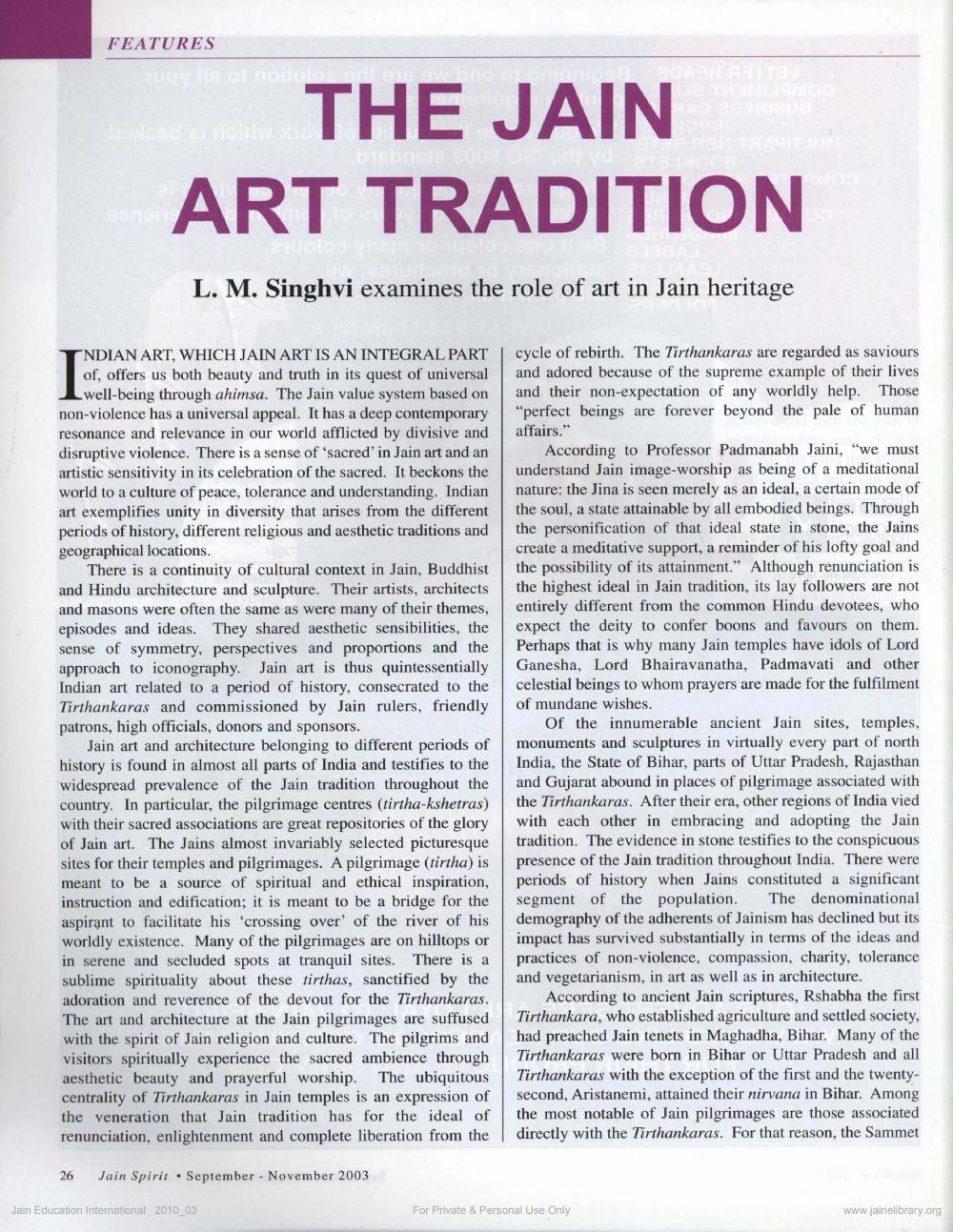________________
FEATURES
THE JAIN ART TRADITION
L. M. Singhvi examines the role of art in Jain heritage
INDIAN ART, WHICH JAIN ART IS AN INTEGRAL PART
of, offers us both beauty and truth in its quest of universal -well-being through ahimsa. The Jain value system based on non-violence has a universal appeal. It has a deep contemporary resonance and relevance in our world afflicted by divisive and disruptive violence. There is a sense of 'sacred' in Jain art and an artistic sensitivity in its celebration of the sacred. It beckons the world to a culture of peace, tolerance and understanding. Indian art exemplifies unity in diversity that arises from the different periods of history, different religious and aesthetic traditions and geographical locations.
There is a continuity of cultural context in Jain, Buddhist and Hindu architecture and sculpture. Their artists, architects and masons were often the same as were many of their themes, episodes and ideas. They shared aesthetic sensibilities, the sense of symmetry, perspectives and proportions and the approach to iconography. Jain art is thus quintessentially Indian art related to a period of history, consecrated to the Tirthankaras and commissioned by Jain rulers, friendly patrons, high officials, donors and sponsors.
Jain art and architecture belonging to different periods of history is found in almost all parts of India and testifies to the widespread prevalence of the Jain tradition throughout the country. In particular, the pilgrimage centres (tirtha-kshetras) with their sacred associations are great repositories of the glory of Jain art. The Jains almost invariably selected picturesque sites for their temples and pilgrimages. A pilgrimage (tirtha) is meant to be a source of spiritual and ethical inspiration, instruction and edification; it is meant to be a bridge for the aspirant to facilitate his 'crossing over' of the river of his worldly existence. Many of the pilgrimages are on hilltops or in serene and secluded spots at tranquil sites. There is a sublime spirituality about these tirthas, sanctified by the adoration and reverence of the devout for the Tirthankaras. The art and architecture at the Jain pilgrimages are suffused with the spirit of Jain religion and culture. The pilgrims and visitors spiritually experience the sacred ambience through aesthetic beauty and prayerful worship. The ubiquitous centrality of Tirthankaras in Jain temples is an expression of the veneration that Jain tradition has for the ideal of renunciation, enlightenment and complete liberation from the
cycle of rebirth. The Tirthankaras are regarded as saviours and adored because of the supreme example of their lives and their non-expectation of any worldly help. Those "perfect beings are forever beyond the pale of human affairs."
According to Professor Padmanabh Jaini, "we must understand Jain image-worship as being of a meditational nature: the Jina is seen merely as an ideal, a certain mode of the soul, a state attainable by all embodied beings. Through the personification of that ideal state in stone, the Jains create a meditative support, a reminder of his lofty goal and the possibility of its attainment." Although renunciation is the highest ideal in Jain tradition, its lay followers are not entirely different from the common Hindu devotees, who expect the deity to confer boons and favours on them. Perhaps that is why many Jain temples have idols of Lord Ganesha, Lord Bhairavanatha, Padmavati and other celestial beings to whom prayers are made for the fulfilment of mundane wishes.
of the innumerable ancient Jain sites, temples, monuments and sculptures in virtually every part of north India, the State of Bihar, parts of Uttar Pradesh, Rajasthan and Gujarat abound in places of pilgrimage associated with the Tirthankaras. After their era, other regions of India vied with each other in embracing and adopting the Jain tradition. The evidence in stone testifies to the conspicuous presence of the Jain tradition throughout India. There were periods of history when Jains constituted a significant segment of the population. The denominational demography of the adherents of Jainism has declined but its impact has survived substantially in terms of the ideas and practices of non-violence, compassion, charity, tolerance and vegetarianism, in art as well as in architecture,
According to ancient Jain scriptures, Rshabha the first Tirthankara, who established agriculture and settled society, had preached Jain tenets in Maghadha, Bihar. Many of the Tirthankaras were born in Bihar or Uttar Pradesh and all Tirthankaras with the exception of the first and the twentysecond, Aristanemi, attained their nirvana in Bihar. Among the most notable of Jain pilgrimages are those associated directly with the Tirthankaras. For that reason, the Sammet
26
Jain Spirit September - November 2003
Jain Education International 2010_03
For Private & Personal Use Only
www.jainelibrary.org




